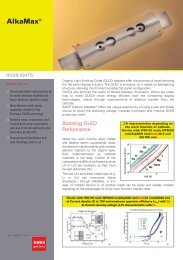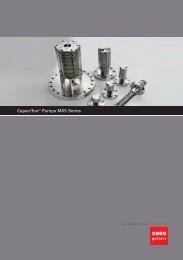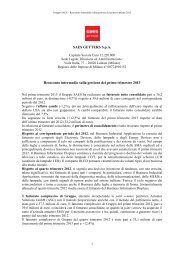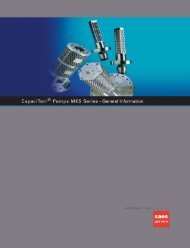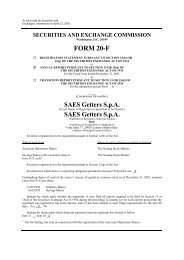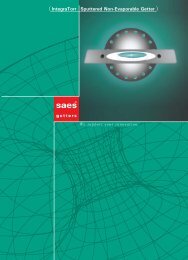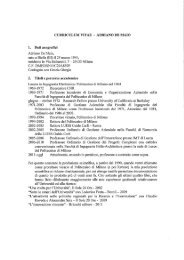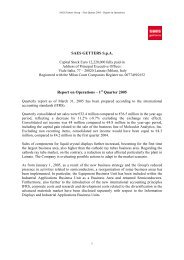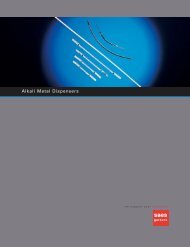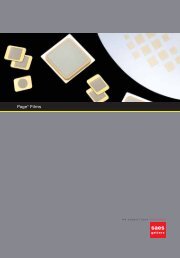sorb ac general.pdf - SAES Getters
sorb ac general.pdf - SAES Getters
sorb ac general.pdf - SAES Getters
- No tags were found...
You also want an ePaper? Increase the reach of your titles
YUMPU automatically turns print PDFs into web optimized ePapers that Google loves.
During <strong>ac</strong>tivation it is advisable not to exceed pressures in the 10 -3 Torr range to avoid phenomenaof corrosion of the heater wire, RF discharges between the heater and other pump elements andcontamination of the gettering material due to the sorption of <strong>ac</strong>tive gases during the <strong>ac</strong>tivationprocess.For this purpose, and depending on the pumping speed of the b<strong>ac</strong>king pump, it may be advisable to<strong>ac</strong>tivate the getter cartridge by successive steps, not applying the full power to the heater at thebeginning of the <strong>ac</strong>tivation process. In this case, re<strong>ac</strong>hing the <strong>ac</strong>tivation temperature may take a fewhours compared to 30 minutes usually needed if full power is applied at the beginning.Operation of SORB-AC Cartridge PumpsWhen <strong>ac</strong>tivated, the SORB-AC cartridge pump can be operated at various temperatures <strong>ac</strong>cording tothe load of <strong>ac</strong>tive gases, taking into <strong>ac</strong>count two main f<strong>ac</strong>ts. First, the higher the temperature, thehigher the diffusivity of the <strong>sorb</strong>ed gases into the bulk of the getter material. Second, the higher thetemperature, the higher the H 2 equilibrium pressure. High temperature operation is preferred whenhigh gas loads are present. In this way it is possible to maintain a high diffusion rate and consequentlya constant pumping speed for all the <strong>ac</strong>tive gases.Temperatures in the range of 280°C are typically suggested for St707, but different values can beadopted. High getter temperature is usually not compatible with UHV operation due to the desorptionof hydrogen from the getter material. For example the use of an St 707 cartridge at 280°C will causean initial hydrogen equilibrium pressure on the getter material in the range of 10 -7 - 10 -8 Torr due tothe residual H 2 content of the alloy and depending on the presence of additional pumping devices.Room temperature operation is indicated when the gas load is low, and for the reason mentionedabove, it is mandatory when the operating pressure is below 10 -8 Torr. When pumping high purityhydrogen, operation at room temperature is also possible with high gas loads due to the high diffusivityof H 2 at that temperature. In this latter case, a careful evaluation of the gas load and of the quantityof gas <strong>sorb</strong>ed is necessary to avoid possible embrittlement.Note that in the curves in Figure 3, the <strong>ac</strong>tual concentration of H 2 in the alloy (and therefore the residualcap<strong>ac</strong>ity) to be known before embrittlement occurs can be determined by a simple measurement ofthe pressure in static v<strong>ac</strong>uum at a given operating temperature.Re<strong>ac</strong>tivation of SORB-AC Cartridge PumpsThe re<strong>ac</strong>tivation of the getter cartridge of a SORB-AC pump is necessary when the cartridge is exposedto air or when it’s pumping speed falls below <strong>ac</strong>ceptable limits. In both cases the surf<strong>ac</strong>e of the gettermaterial becomes covered by a passivation layer of mainly carbides and oxides. If re<strong>ac</strong>tivation ispreceded by an air exposure (and a successive pump down cycle), it should follow the same procedureand has the same char<strong>ac</strong>teristics of the first one. If the re<strong>ac</strong>tivation follows normal in-v<strong>ac</strong>uum operationwithout air venting, it may be shorter and carried out at a lower temperature (indicatively 25% lower).Moreover during a re<strong>ac</strong>tivation which follows normal in-v<strong>ac</strong>uum operation the only gas released ishydrogen. Through successive re<strong>ac</strong>tivations it is possible to use the entire cap<strong>ac</strong>ity of the gettermaterial. When the pumping speed no longer recovers sufficiently after re<strong>ac</strong>tivation, the cartridgemust be repl<strong>ac</strong>ed.Regeneration of SORB-AC Cartridge PumpsHydrogen and hydrogen isotopes <strong>sorb</strong>ed by the cartridge can be released from the getter materialthrough a regeneration treatment. Regeneration is necessary when:••the pumping speed for hydrogen or hydrogen isotopes has fallen below <strong>ac</strong>ceptable limits becausethe equilibrium pressure has been appro<strong>ac</strong>hed.equilibrium is far from being re<strong>ac</strong>hed but the hydrogen or hydrogen isotopes quantity pumped isappro<strong>ac</strong>hing the embrittlement limit of 20 liter Torr/g.Embrittlement of the material takes pl<strong>ac</strong>e when the quantity of hydrogen <strong>sorb</strong>ed in the getter materialis high enough to modify the mechanical char<strong>ac</strong>teristics of the alloy causing it to flake into smallparticles from the substrate. The process of hydrogen sorption and successive desorption (regeneration),can be visualized on the Sieverts’ plots of the specific alloy (see Figure 6).The temperature increase of the getter alloy establishes a high hydrogen equilibrium pressure, allowinghydrogen removal by means of a standard b<strong>ac</strong>king pump. From the plot in Figure 5 can see that theregeneration process will be more effic<strong>ac</strong>ious at higher temperature.We support your innovation5



